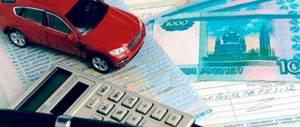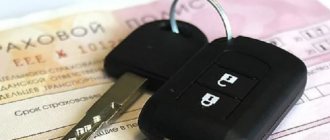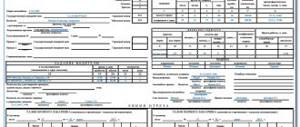All vehicle owners are well aware that the amount they pay for an MTPL policy directly depends on driving experience and the number of accidents in which the motorist was involved through his own fault (in the case of insurance payment).
Dear readers! The article talks about typical ways to resolve legal issues, but each case is individual. If you want to find out how to solve your particular problem , contact a consultant:
+7 (499) 938-81-90 (Moscow)
+7 (812) 467-32-77 (Saint Petersburg)
8 (800) 301-79-36 (Regions)
APPLICATIONS AND CALLS ARE ACCEPTED 24/7 and 7 days a week.
It's fast and FREE !
You can calculate the price for the policy and the discounts that the driver can take advantage of using the KBM (bonus-malus) coefficient. Now this is the only opportunity that allows you to reduce your insurance payment.
Its task is to encourage motorists who drive without accidents by receiving discounts, and to punish drivers who cause accidents by increasing the price of the insurance policy.
What is KBM in MTPL insurance?
This is a system of insurance coefficients that determine the price of the policy depending on the history of insured events. The name "bonus malus" comes from the Latin words bonus and malus, meaning "good" and "bad." The purpose of the KBM is to increase the interest of road users in careful driving. Accident-free drivers are entitled to a discount; insurance for those at fault will cost more.
In the Russian Federation, KBM was introduced in 2003. The automated system appeared in 2012 (data on all concluded OSAGO contracts is received within 1-3 days). Now, when switching to another insurance company, a certificate of accident-free driving is not required. The insurer independently requests data from the RSA when issuing a policy.
Check the KBM against the database of the Russian Union of Auto Insurers
The bonus-malus coefficient is a tool used by auto insurers to reduce or increase the cost of a service.
It is possible to calculate the KBM online, without leaving your home, on the page of the Russian Union of Auto Insurers -autoins.ru. The base has a cascommeter for calculations. Go to the “ MTPL ” tab, find the section “ Calculation of the cost of MTPL ” and then click “ Calculate KBM ”.
Expert opinion
Valery Volkov
Insurance expert and auto lawyer
OSAGO calculator
The issued value of KBM RSA is relevant only at the time of the current check. It may appear different when the information in the registry is updated.
It may turn out that the discount does not meet your expectations, first double-check the information:
- Whether there were any payments from the insurance company during the period of validity of the previous contract;
- How much time has passed since the incident, the indicator is updated only after a year;
- What period has passed since the last policy was completed? If you have not renewed the contract for more than a year, then the indicator again becomes equal to one.
If, after checking the information, the BMR is still unreasonably high for you, you can restore it. Since the end of 2015, a new procedure scheme has been created. You have the opportunity to clarify this issue with your policy issuing company. After this, the auto insurer matches the data using the PCA database. If the operator notices an error, he will correct it.
If the method proposed above does not work, then there is PCA to solve the issue. You will be required to submit an official application and documents confirming your last name, first name, patronymic, your date of birth, as well as driver’s license details.
You can send a request in three ways:
- Send by Russian Post to the address: 115093, Moscow, st. Lyusinovskaya, 27, building 3 ;
- Deliver in person to the central office of the union of insurers;
- Send by e-mail: [email protected] or [email protected] .
Specialists will consider your claim within 30 days . If the outcome is positive, the operator will make changes to the AIS.
Expert opinion
Valery Volkov
Insurance expert and auto lawyer
OSAGO calculator
If the indicator remains at the same level, then you have the opportunity to resolve the issue through the Central Bank. The Consumer Protection Society and Rospotrebnadzor are also involved in issues of restoring the coefficient. They have the right to conduct verification through their own channels.
How to determine the Bonus-Malus ratio
It’s easy to determine your KBM. It is enough to take the current table of values (last changes made on April 1, 2020) and a current or expired compulsory motor liability insurance policy.
No accidents or accidents
The easiest way to determine KBM. No table needed. We take the policy, opposite our last name or in paragraph 7 we find our KBM and subtract 0.5 from the indicated value.
After an accident
If the driver is found to be at fault for an accident, then the CBM will be affected by the number of incidents during the insurance year (from April 1 to March 31). To determine the KBM, look for your class in the table (indicated in the policy opposite the last name or in paragraph 7). In the column with the number of accidents, select the appropriate number. At the intersection there will be the desired value.
How to find out and check
Each owner or driver of a vehicle can find out the KBM in a special table before taking out insurance for the next year. It is worth noting that in the 1st year of the policy, each individual driving an insured vehicle will be assigned class 3, and accordingly the bonus will be equal to 1. If the driver does not commit a single accident during the year of validity of the document, then he will be in next year assigned 4th grade.
You can learn more about how to find out the accident-free rate under compulsory motor liability insurance in our previous article.
Calculation of KBM for unlimited insurance
With limited insurance, the BMI of all admitted drivers is taken into account. To calculate the cost of the policy, the BMI of the driver with the worst insurance class is used. For example, they plan to include drivers of class 5 (KBM 0.9) and class 2 (KBM 1.4) into the policy. For calculation, take the value 1.4.
With insurance without restrictions , the class within the KBM system is assigned only to the owner of the car. The class is determined by the last expired insurance contract. If any driver who gets behind the wheel of the car specified in the policy causes an accident, the owner’s MBI will worsen.
If the previous policy was without restrictions, and the new insurance was with restrictions, then in the absence of payments for the previous year, the insurer is obliged to assign a lower CBM. But only on condition that the owner and the policyholder are the same.
Features of the coefficient
In order to understand what the purpose of the introduction of CBM in the field of compulsory motor insurance is, it is necessary to examine this concept in more detail. Thus, it is important to become familiar with the available classes, the nature of the calculation of the indicator, as well as the application of discounts in different types of policies. In addition, the driver must understand how he can check the current class and what to do if the CBM, which should be based on the insurance history, is reset to zero.
What does KBM OSAGO depend on?
First of all, KBM depends on the driver’s accident-free operation. Initially, a standard class number 3 is assigned, which has a coefficient of 1.
That is, in this case, the cost of insurance does not increase or decrease. But if the driver does not get into an accident for which he is found guilty, then the class increases every year. Thus, KBM is also called a discount for accident-free operation, since the presence of a class higher than 3 makes it possible to pay the cost of insurance only partially. But there are also situations when the indicator is reset to zero. This can happen primarily due to an error by a specialist who incorrectly entered driver information into the database, but the KBM is also reset when purchasing a new car, changing a driver’s license or changing insurance to unlimited. True, in most cases the class can be restored.
What are the classes?
In total, there are 15 classes in insurance, of which four are negative, that is, malus, and 10 are positive, called bonuses.
One standard one, which does not change the cost in any way, is where any driver begins his insurance period. The minimum class, which leads to the maximum cost of the policy, is M, and the maximum is considered to be the 13th, which allows you to get a discount of 50% of the policy price. The class can drop significantly if accidents occur, and in any case, whatever the class, committing four or more accidents in a year will reduce it to the minimum. Therefore, if we are talking about which class is the best, then naturally it is the one that gives the minimum coefficient.
Photo: KBM table
How is the indicator calculated?
For each year spent without accidents, the driver’s class increases by 1, thus the coefficient also decreases, by 0.05 for each class, starting with the 3rd, which answers the question of what KBM 1 means.
At the same time, initially the standard KBM is 1, so in ten years without accidents it is quite possible to reduce the coefficient to 0.5, and the class will become 13th.
A prerequisite is the absence of accidents due to the driver’s fault, and if there were any, the class is downgraded in accordance with the table of classes contained in the Directive, authored by the Central Bank. It is worth noting that for 11 months the grade is calculated in the same way as for a full year.
Validity
In principle, the class is valid as long as a person uses Rosgosstrakh insurance, and if a short-term break is allowed, for example, when the insurance has expired and a new policy has not been purchased, then the coefficient is not lost. The validity period is the year during which a person will not have coverage from the date of completion of the previous policy.
Who enters information about him into the database
After each year and at the start of insurance, information about the current KBM is entered into the database by employees of an insurance company in the city of Moscow or another. Only they have access to the unified information system of RSA, and no one else has the right to change the information in it.
The driver himself cannot influence the information in the database, just as police officers and other organizations have nothing to do with it.
Thus, you can apply for data correction to employees of insurance companies, although anyone can find a class in the database.
How the discount is applied
There are differences in the scope of application of the discount that is provided under the current BSC. The main differences are in the use of the coefficient for open and limited insurance. First of all, it should be understood that if a transition is made from limited to unlimited insurance, then the BMI is reduced to the standard one, which is prescribed by law.
Which KBM is assigned to a novice driver, see the article: what KBM does a novice driver have. Read about checking the KBM through the official RSA website here.
This can happen even with a coefficient of 0.85. So, when calculating the percentage discount, a coefficient of 0.65 will give a 35% reduction in the cost of the policy.
With open insurance
Open RESO insurance assumes that anyone who has a driver's license can drive a car.
In this case, only the vehicle owner’s KBM, obtained from the vehicle ownership documents, matters. After all, the value of this indicator for everyone who uses this car is simply not important. In addition, if there are two cars, then the KBM will also be calculated based on the owner’s indicator.
With limited
When the policy is limited, only drivers under the contract who are included in the insurance can drive the car.
The final cost of compulsory motor liability insurance is calculated based on the minimum class that is included in the policy. Consequently, when drivers with classes 9, 6 and 5 are included in it, the calculation will be made according to the coefficient provided for class 5, and the rest will simply not be taken into account.
Where to check your bonus malus online
To check the class, you can use the help of insurance agents; all you have to do is come to the company.
Photo: KBM check on the RSA website. Part 1
But it is much easier to check the KBM if you use online resources that are linked to the RSA database, doing this using the policy number, driver’s license and other documents.
Photo: Checking KBM on the RSA website.
Part 2 There are three verification options:
| According to the official websites of insurance companies | Which allow you to pre-calculate the CBM and the cost of insurance, for example, Alfastrakhovanie |
| Third Party Resources | Which have nothing to do with insurers, but are also connected to the RSA database |
| The website of the Russian Union of Auto Insurers itself | Which has a special form for checking the current driver class |
Carrying out calculations yourself
It is quite simple to calculate the current KBM; the main thing is to understand how many years have passed since the first insurance was taken out, and whether there were any accidents during this period due to the driver’s fault. So, if, for example, five years have passed since the first registration, and there has not been a single accident, then the driver will use 8th class with a coefficient of 0.75. And if this year he has one accident for which he is guilty, then he will drop to 5th class with a coefficient of 0.9.
Class at the beginning of the annual insurance
Every year on April 1, the KBM is recalculated. The new insurance class depends on your driving history over the last 12 months. Accident-free drivers are given a discount, and an increasing factor is applied to those responsible for road incidents.
It is important to understand that early termination of a break-even contract (even a day or an hour before expiration) takes away the discount accumulated over the period from the driver. When purchasing a new policy, the insurer will apply the same BMR as at the beginning of the early closed contract.
If there is a break in insurance for more than 12 months, the accumulated discount is no longer reset.
The increasing coefficient does not reset to zero during a long break. The history of insurance events is stored in RSA.
Table
To use the coefficient table, you must proceed as follows:
- The current “Malus” is selected, which is located in the last column located on the left.
- The number of accidents caused by the fault of the insured person is selected in the top line.
- In the cell located at the intersection of these two indicators you need to look at the bonus that will be valid next year.
Attention! To find out what KVS KBM means in the table, you need to pay attention to the footnotes located under it.
Driver classes in the KBM table
There are 15 classes in the OSAGO system (M, 0 and from 1 to 13). Each class has a coefficient depending on the number of accidents at the end of the insurance year. Class 13 is considered the highest (can be achieved after 10 years of accident-free driving). The lowest class is M, insurance for such drivers is the most expensive. It is easy to get into class M even with one accident in which the driver was found guilty (it all depends on the class in force at the time of purchasing the policy). For example, a driver with class 13 gets into 7 for one accident. And a driver of class 6 gets into 4 for a single accident.
The current class is indicated in the policy opposite the driver’s full name and in paragraph 7 , which lists all the coefficients used in the calculation.
Is it possible to correct it in the AIS RSA database?
Quite often, car enthusiasts are faced with a situation where the RCA database produces a coefficient that does not correspond to reality.
It happens that for many years of accident-free driving, the policyholder receives a coefficient that is equal to one, or less than what is required for break-even insurance.
Let's look at the reasons that cause errors:
- in the case of replacing a driver's license with a new one, the data in the database may not have been corrected, and only a record with the data of the old license remains. To correct the situation, it is necessary to make a request to the RSA indicating the data of both the old and new identification;
- an error/typo was made when entering data into the database (wrong letter or number);
- in case the driver is included as an authorized person to drive in several policies. For example, A.N. Sokolov, having his own car, is allowed to drive the car of his wife with 1 year of driving experience. In the policy of Sokolov A.N. the coefficient is recorded as 0.6, and in the wife’s policy it is 0.95, since her experience is 1 year. Consequently, when transferring data from both policies, KBM Sokolova A.N. equals 0.95. 4.
- In case of bankruptcy of the insurance company and failure to transfer data to the PCA system.
How does the OSAGO class affect the discount?
Upon first insurance (the policy is purchased for the first time), class 3 is automatically assigned (with KBM = 1). Since there is no insurance history, there is nothing to reward or punish for. In the future, with trouble-free driving, the BMR is reduced annually by 0.5 units, the discount gradually increases. If a driver is found to be at fault for an accident, an increasing factor is applied. The amount depends on the number of incidents per year (only those for which the policyholder is at fault are taken into account). For example, the owner of the policy was involved in 5 accidents and was found guilty in two cases. They will be punished, respectively, for 2 accidents.
Please note that the insurance year lasts from April 1 to March 31.
How is it calculated
"Bonus-Malus" is calculated based on data from all previous agreements related to road accidents:
- the number of insurance payments made for accidents in which the insured person (driver or owner) was at fault;
- bonus that was assigned upon concluding the last contract, the validity period of which has already ended.
Restoration of KBM
To restore the KBM, you need to write a letter to the insurer. The following information must be provided:
- passport details of the policyholder;
- series and number of rights (current and previous);
- information about the insurance contract;
- the essence of the problem.
The application can be filled out by hand or on a computer by downloading the form on the Internet. If the insurer does not respond to the appeal, then it is advisable to file a complaint with the RSA (consideration period is 3-4 months), the Prosecutor's Office and the Central Bank of the Russian Federation.
Expert opinion
Ivan Strahovsky
Insurance expert
OSAGO calculator
Review results may vary. The KBM may be left unchanged, lowered (the error will be corrected) or increased. The latter is possible with unlimited insurance (the other driver was found to be at fault). The vehicle owner's KBM will deteriorate.
How is the last ended contract determined?
All data on signed insurance contracts is stored in the AIS RSA. When calculating the cost of a new policy, the insurance company is obliged to request the necessary information from the unified register. For example, an individual entered into the first contract in 2021, which will not be used to determine the initial coefficient. The second agreement, issued for a year, ended on the date of signing the new insurance contract. In this case, when calculating MTPL insurance, it will be considered the last.
RSA statistics on the number of drivers who received a MTPL discount for accident-free driving
About 80% of car owners use the discount for clean driving without accidents. That is, 50 million people have a bonus-malus ratio of less than one. The data was provided by the president of the union, Igor Yurgens.
About 30% of drivers enjoy a discount of more than 20%. This is about 20 million people.
A little more than 15% of car owners earned a coefficient of 0.5. That's 9.5 million drivers.
Compared to previous periods, the percentage of drivers with a discount has increased. This suggests that there are fewer accidents, and the financial literacy of the population has increased.
Expert opinion
Valery Volkov
Insurance expert and auto lawyer
OSAGO calculator
According to statistics, the vast majority of vehicle owners have a ratio higher than they could for two reasons. Firstly, they did not take care in advance to transmit the changes to the insurance company in a timely manner when changing their data. This must be done so that similar problems do not arise later. Secondly, insurance company employees do not always perform their duties conscientiously and often do not submit updated information to the RSA on time. In this case, the system cannot find information about the driver, which is why he is automatically assigned an indicator equal to one, like a beginner.
The reason for the increased value may also be when the motorist did not purchase a real MTPL policy.
What is the KBM tied to - the car or the driver?
Initially, the legislation on compulsory motor liability insurance stipulated the binding of the KBM to the car.
More information about the legislation on compulsory motor liability insurance can be found in the section - “Law on compulsory motor liability insurance and other regulations”
This caused a lot of controversy. Since car owners who sold their old car and bought a new one were faced with the fact that their accumulated accident-free discount was reset to zero. KBM was equal to 1 (unit).
Therefore, since 2008 the approach has been changed.
Now the KBM is tied to the driver. And changing a car does not affect the amount of the discount for accident-free operation.
Moreover, the transition to linking the KBM to the driver made it possible to more accurately determine the cost of the MTPL policy, where more than one driver is included in the list of persons allowed to drive.











